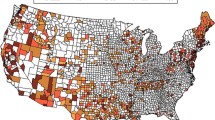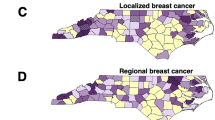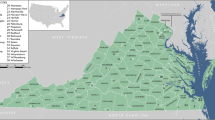Abstract
Manganese is an element essential for health in trace amounts, but toxic at higher exposures. Since manganese is replacing lead in gasoline globally, evaluation of potential cancer effects is essential. To determine whether environmental manganese is related to cancer at the county level in North Carolina (n = 100 counties; North Carolina 2000 population = 8,049,313), we carried out an ecological study using data from the North Carolina State Center for Health Statistics, North Carolina Geological Survey, US Geological Survey, and US Census. County-level all-cause and cancer mortality rates between 1997 and 2001 reported in deaths per 100,000 population associated by multivariable regression with logarithmically transformed groundwater (microgram per liter) and airborne (microgram per cubic meter) manganese concentrations by county measured between 1973 and 1979 (water) and in1996 (air). Models controlled for county characteristics. Median all-cause and cancer mortality rates by county in North Carolina (1997–2001) exceeded those of the USA (2000). For each log increase in groundwater manganese concentration, there was a corresponding county-level increase of 12.10 deaths/100,000 population in all-site cancer rates, 2.84 deaths/100,000 in colon cancer rates, and 7.73 deaths/100,000 in lung cancer rates. For each log increase in airborne manganese concentration, there was a corresponding county-level decrease of 8.10 deaths/100,000 population in all-site cancer rates, 3.28 deaths/100,000 in breast cancer rates, and 3.97 deaths/100,000 in lung cancer rates. Neither groundwater nor air concentrations of manganese correlated with county-level all-cause or prostate cancer death rates. These are the first data we know of to document a potential relationship between environmental manganese and population-level cancer death rates. The positive association between groundwater manganese and specific cancer mortality rates might be a function of the high concentrations measured, while the inverse relationship between air manganese and death rates might point toward adequate (e.g., healthy) county-level manganese exposures. Since manganese is replacing lead in gasoline globally, these ecological findings should be confirmed at the individual level or in animal models.
Similar content being viewed by others
References
Agency for Toxic Substances and Disease Registry (ATSDR) (2008) Toxicological profile for Manganese (Draft for Public Comment). U.S. Department of Health and Human Services, Public Health Service, Atlanta
Hanzlik RP, Bhatia P, Stitt R et al (1980) Biotransformation and excretion of methylcyclopentadienyl manganese tricarbonyl in the rat. Drug Metab Dispos 8:428–433
Stoner GD, Shimkin MB, Troxell MC, Thompson TL, Terry LS (1976) Test for carcinogenicity of metallic compounds by the pulmonary tumor response in strain A mice. Cancer Res 36:1744–1747
Hafeman D, Factor-Litvak P, Cheng Z et al (2007) Association between manganese exposure through drinking water and infant mortality in Bangladesh. Environ Health Perspect 115:1107–1112
Gottschalk LA, Rebello T, Buchsbaum MS, Tucker HG, Hodges EL (1991) Abnormalities in hair trace elements as indicators of aberrant behavior. Compr Psychiatry 32:229–237
Aschner M, Erikson KM, Dorman DC (2005) Manganese dosimetry: species differences and implications for neurotoxicity. Crit Rev Toxicol 35:1–32
Aschner M, Connor JR, Dorman DC et al (2002) Manganese in health and disease. From transport to neurotoxicity. In: Massaro EJ (ed) Handbook of neurotoxicology: volume 1. Humana, Totowa, pp 195–209
Solomon GM, Huddle AM, Silbergeld EK, & Herman J (1997) Manganese in gasoline: are we repeating history? New Solutions. Winter:17–25
Fed Reg US Federal Register (2003) Contaminants on the drinking water contaminant candidate list. Fed Regist 68(138):42897–42906 July 18
Gavin CE, Gunter KK, Gunter TE (1992) Mn sequestration by mitochondria and inhibition of oxidative phosphorylation. Toxicol Appl Pharmacol 115:1–5
Chuang TC, Liu JY, Lin CT et al (2007) Human manganese superoxide dismutase suppresses HER2/neu-mediated breast cancer malignancy. FEBS Lett 581:4443–4449
Zejnilovic J, Akev N, Yilmaz H, Isbir T (2009) Association between manganese superoxide dismutase polymorphism and risk of lung cancer. Cancer Genet Cytogenet 189:1–4
Ebert EC (1996) Mechanisms of cancer binding to substratum and cells. Dig Dis Sci 41:1551–1556
Gordis L (2000) Epidemilogy, 2nd edn. Saunders, Philadelphia, pp 185–187
US Census Bureau. Accessed at http://www.census.gov
North Carolina State Center for Health Statistics. Accessed at http://www.schs.state.nc.us
US EPA. Technology Transfer Network, National Air Toxics Assessment. Accessed at http://www.epa.gov/ttn/atw/nata/tablconc.html
Reid JC (1993) A geochemical atlas of North Carolina, USA. J Geochem Explor 47:11–27
Spangler JG, Reid JC (2009) Groundwater manganese and homicide rates in North Carolina, USA. Environ Geochem Health (in press)
Arias E, Smith BL (2003) Deaths: preliminary data for 2001. National Vita Statistics Reports; vol 51, no 5. National Center for Health Statistics, Hyattsville
NCI Surveillance Epidemiology and End Results. Accessed on February 11, 2009. Accessed at http://seer.cancer.gov/faststats/selections.php?series=cancer
Joo NS, Kim SM, Jung YS, Kim KM (2008) Hair iron and other minerals in breast cancer patients. Biol Trace Elem Res 129:28–35
Kilic E, Saraymen R, Demiroglu A, Ok E (2004) Chromium and manganese levels in the scalp hair of normals and patients with breast cancer. Biol Trace Elem Res 102:19–25
Davis CD, Greger JL (1992) Longitudinal changes of manganese-dependent Superoxide dismutase and other indexes of manganese and iron status in women. Am Clin Nutr 55:747–752
Davis CD, Ney DM, Greger JL (1990) Manganese, iron and lipid interactions in rats. J Nutr 120:507–513
deRosa G, Keen CL, Leach RM, Hurley LS (1980) Regulation of superoxide dismutase activity by dietary manganese. J Nutr 110:795–804
Malecki EA, Huttner DL, Greger JL (1994) Manganese status, gut endogenous losses of manganese, and antioxidant enzyme activity in rats fed varying levels of manganese and fat. Biol Trace Elem Res 42:17–29
Zidenberg-Cherr S, Keen CL, LÃnnerdal B, Hurley LS (1983) Superoxide dismutase activity and lipid peroxidation in the rat: developmental correlations affected by manganese deficiency. J Nutr 113:2498–2504
Davis CD, Feng Y (1999) Dietary copper, manganese and iron affect the formation of aberrant crypts in colon of rats administered 3, 2-dimethyl-4-aminobiphenyl. J Nutr 129:1060–1067
DiPaolo JA (1964) The potentiation of lymphosarcoma in mice by manganese chloride. Fed Proc 23:393
Elias Z, Mur JM, Pierre F et al (1989) Chromosome aberrations in peripheral blood lymphocytes of welders and characterization of their exposure by biological samples analysis. J Occup Med 31:477–483
Jablonická A, Polakova H, Karelova J et al (1989) Analysis of chromosome aberrations and sister-chromatid exchanges in peripheral blood lymphocytes of workers with occupational exposure to the mancozeb-containing fungicide Novozir Mn80. Mutat Res 224:143–146
Lima PDL, Vasconcellos MC, Bahia MO et al (2008) Genotoxic and cytotoxic effects of manganese chloride in cultured human lymphocytes treated in different phases of cell cycle. Toxicol In Vitro 22:1032–1037
Mokdad AH, Marks JS, Stroup DF, Gerberding JL (2004) Actual causes of death in the United States, 2000. JAMA 291:1238–1245
Freeman H (1991) Race, poverty and cancer. JNCI J Natl Cancer Inst 83(8):526–527
Pippin CG, Reid JC, Withers C (2005) Arsenic occurrence in the unconfined fractured bedrock aquifer system of the North Carolina Piedmont. Geological Society of America Abstracts 37:171
Cui Y, Vogt S, Olson N, Glass AG, Rohan TE (2007) Levels of zinc, selenium, calcium and iron in benign breast tissue and risk of subsequent breast cancer. Cancer Epidemiol Biomark Prev 16:1682–1685
Garland M, Morris JS, Colditz GA et al (1996) Toenail trace element levels and breast cancer: a prospective study. Am J Epidemiol 144:653–660
US Environmental Protection Agency. National recommended water quality criteria. Washington, DC: U.S. Environmental Protection Agency, Office of Water, Office of Science and Technology. Accessed at http://www.epa.gov/waterscience/criteria/nrwqc-2006.pdf
Acknowledgments
Dr. Spangler had full access to all data used in this study and takes responsibility for the integrity of the data and the accuracy of the data analysis. Dr. Spangler has worked previously as a plaintiff expert witness in a lawsuit alleging unhealthy manganese exposures from drinking water. Dr. Reid works for the North Carolina Geological Survey, which collected the groundwater manganese measurements. The views in this study are his own and do not necessarily reflect those of the North Carolina Geological Survey.
Author information
Authors and Affiliations
Corresponding author
Rights and permissions
About this article
Cite this article
Spangler, J.G., Reid, J.C. Environmental Manganese and Cancer Mortality Rates by County in North Carolina: An Ecological Study. Biol Trace Elem Res 133, 128–135 (2010). https://doi.org/10.1007/s12011-009-8415-9
Received:
Accepted:
Published:
Issue Date:
DOI: https://doi.org/10.1007/s12011-009-8415-9




